Tideline at Messums West





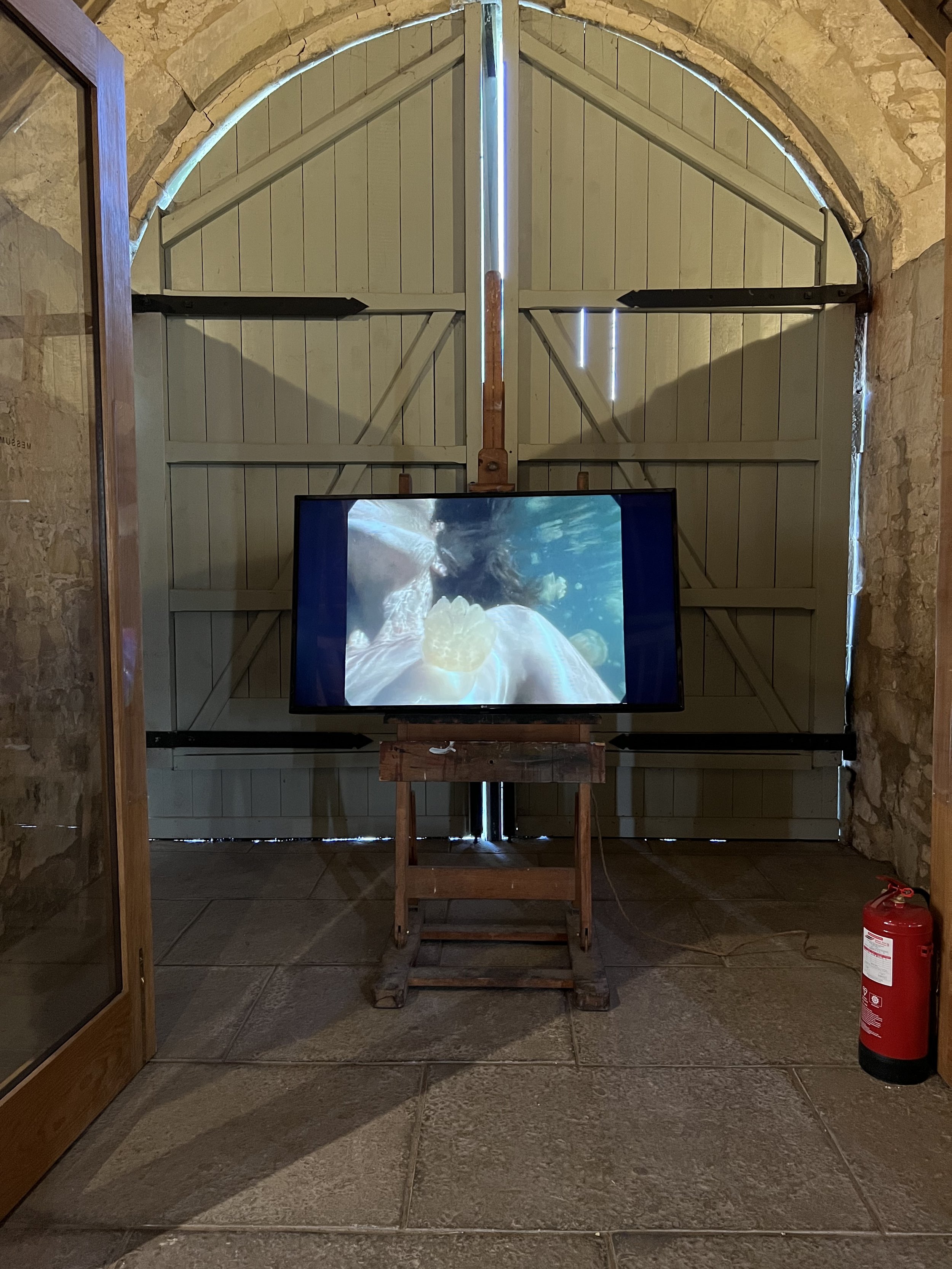
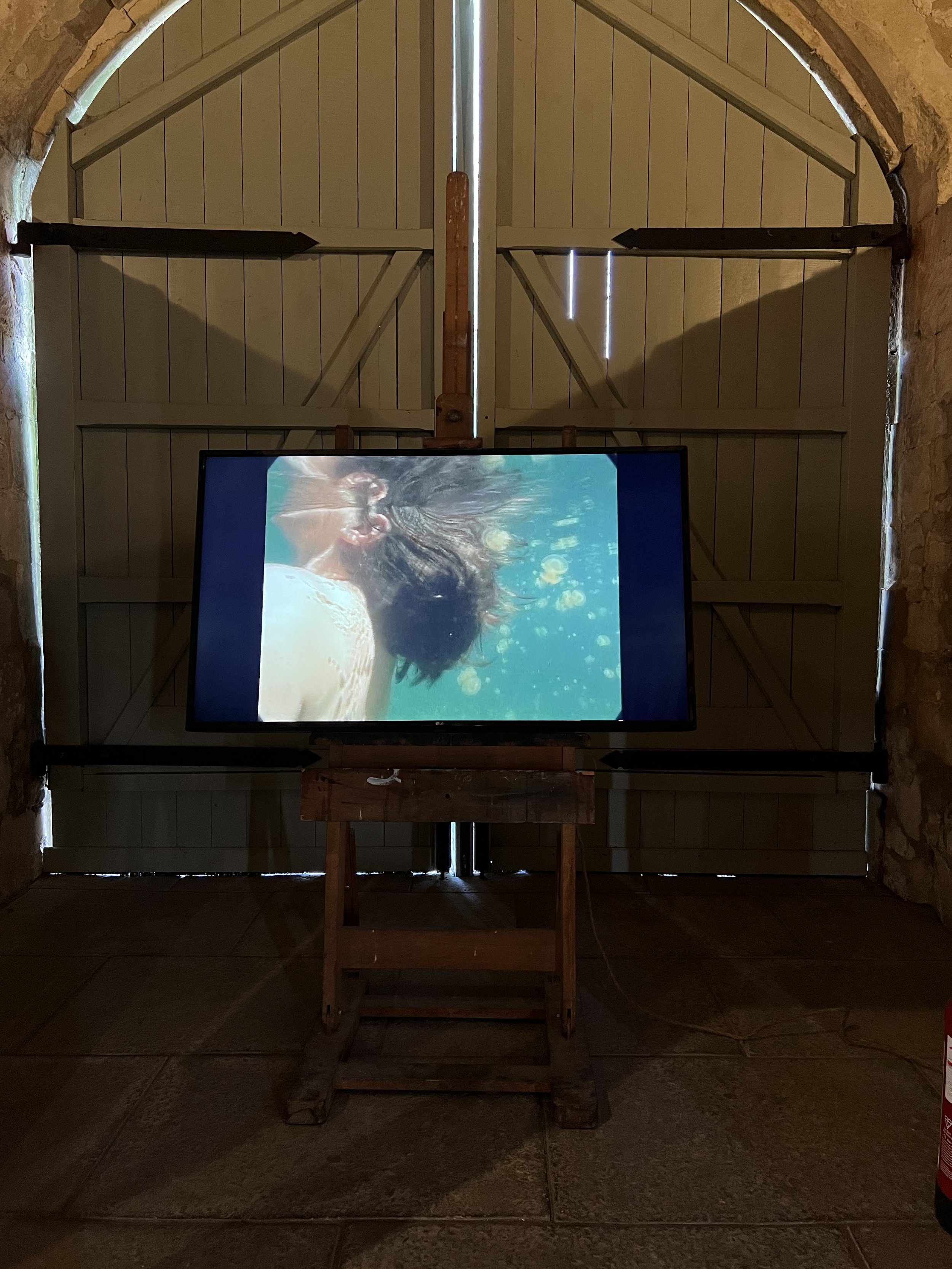

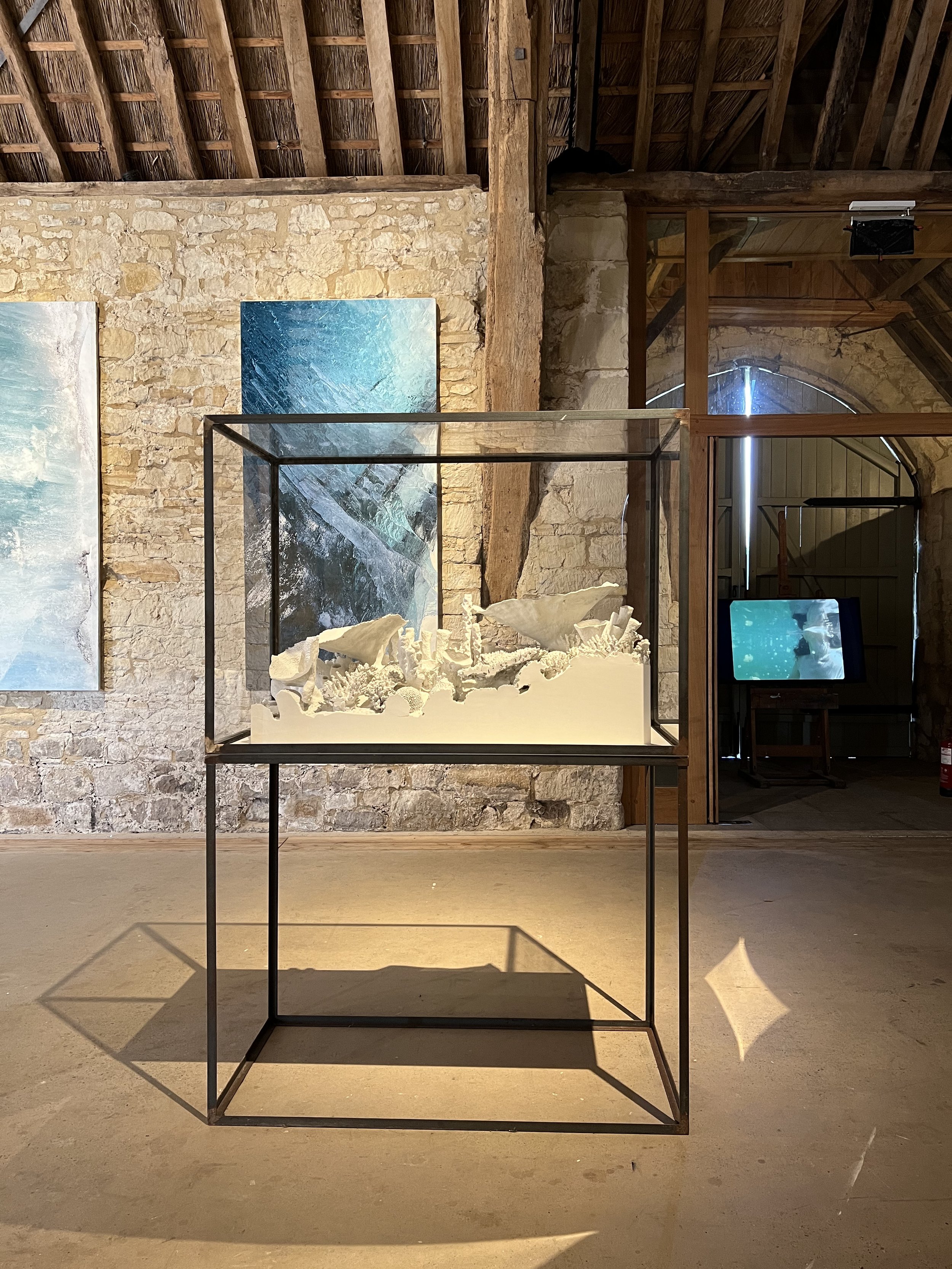
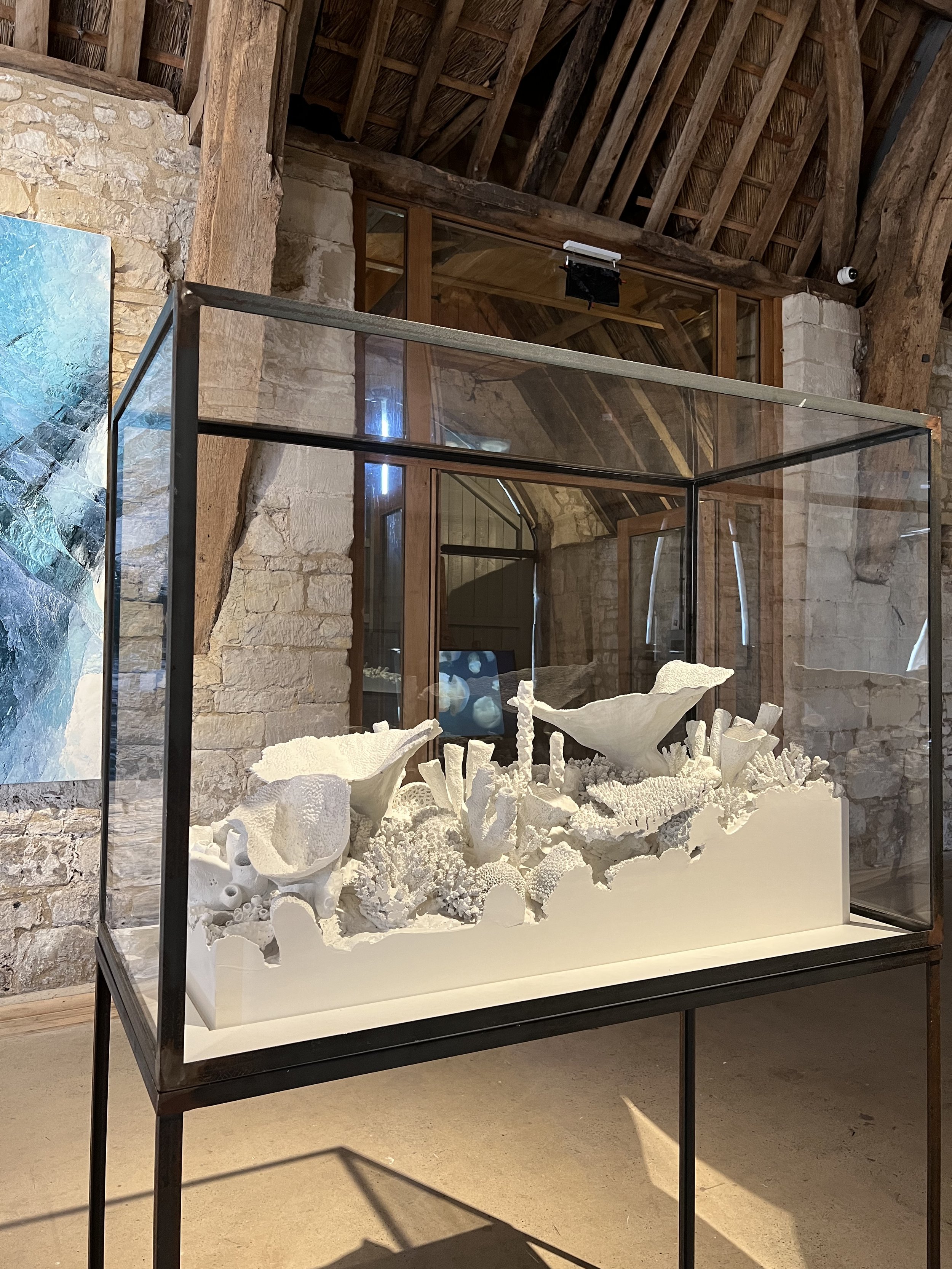
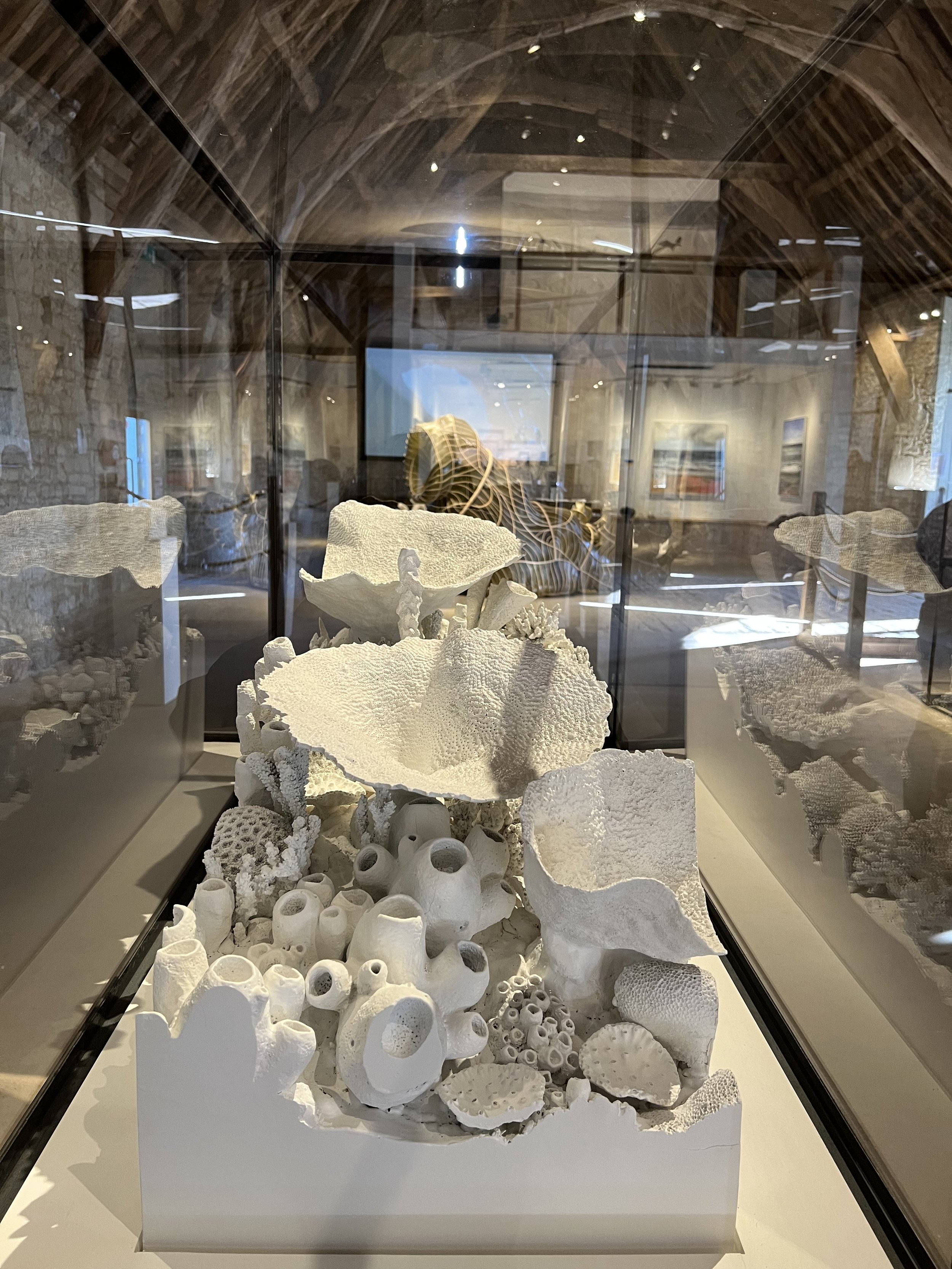
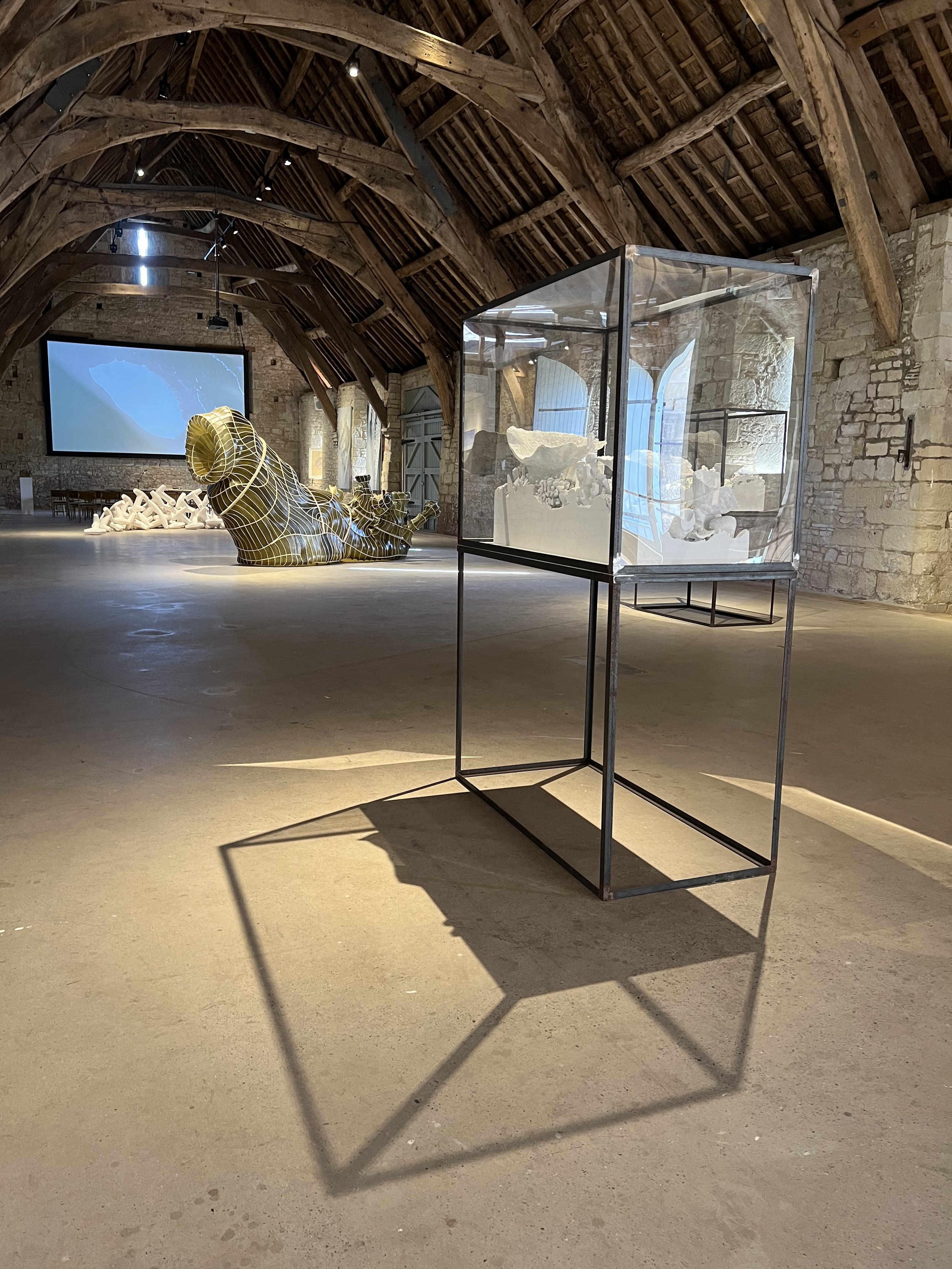
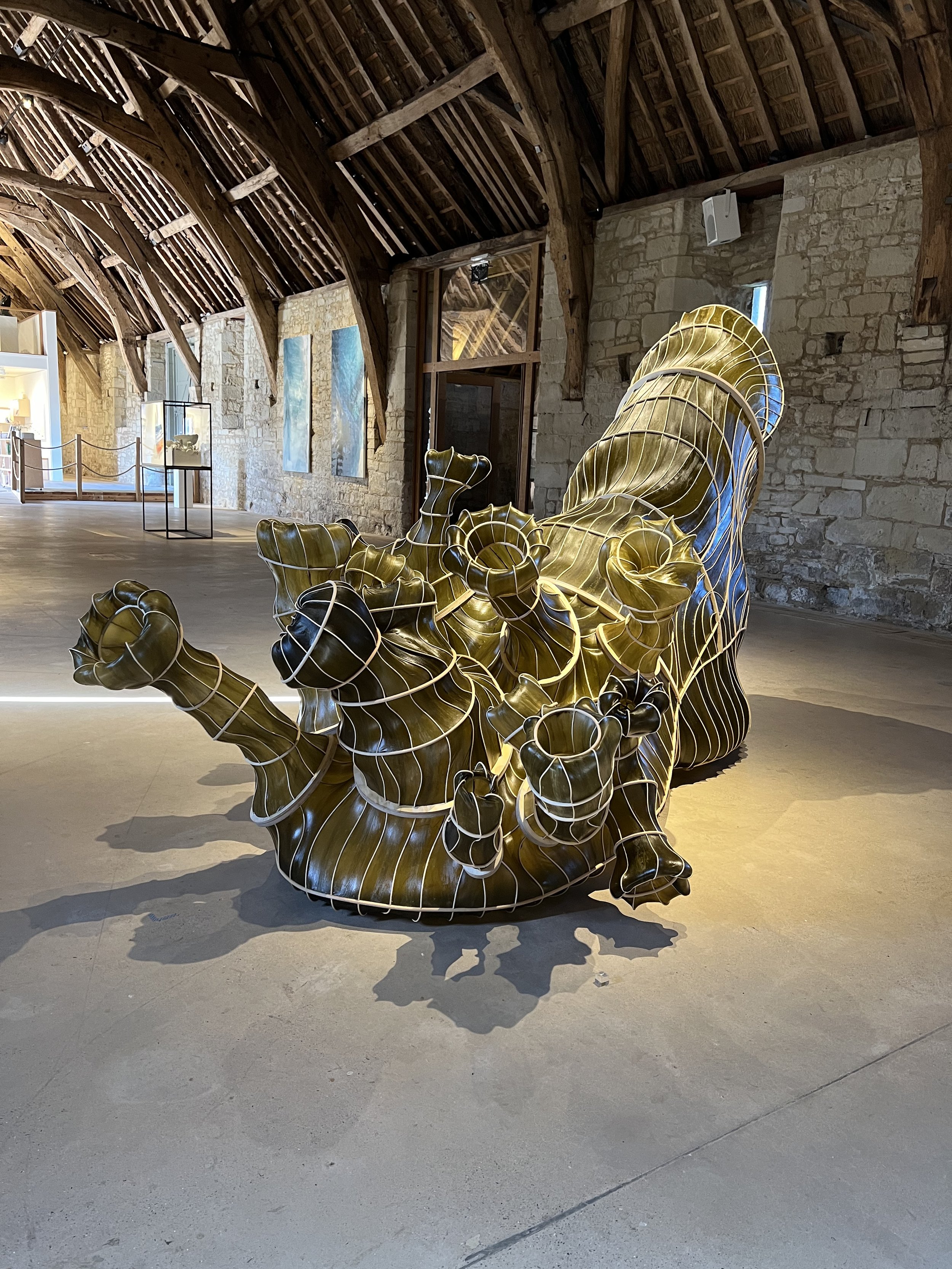
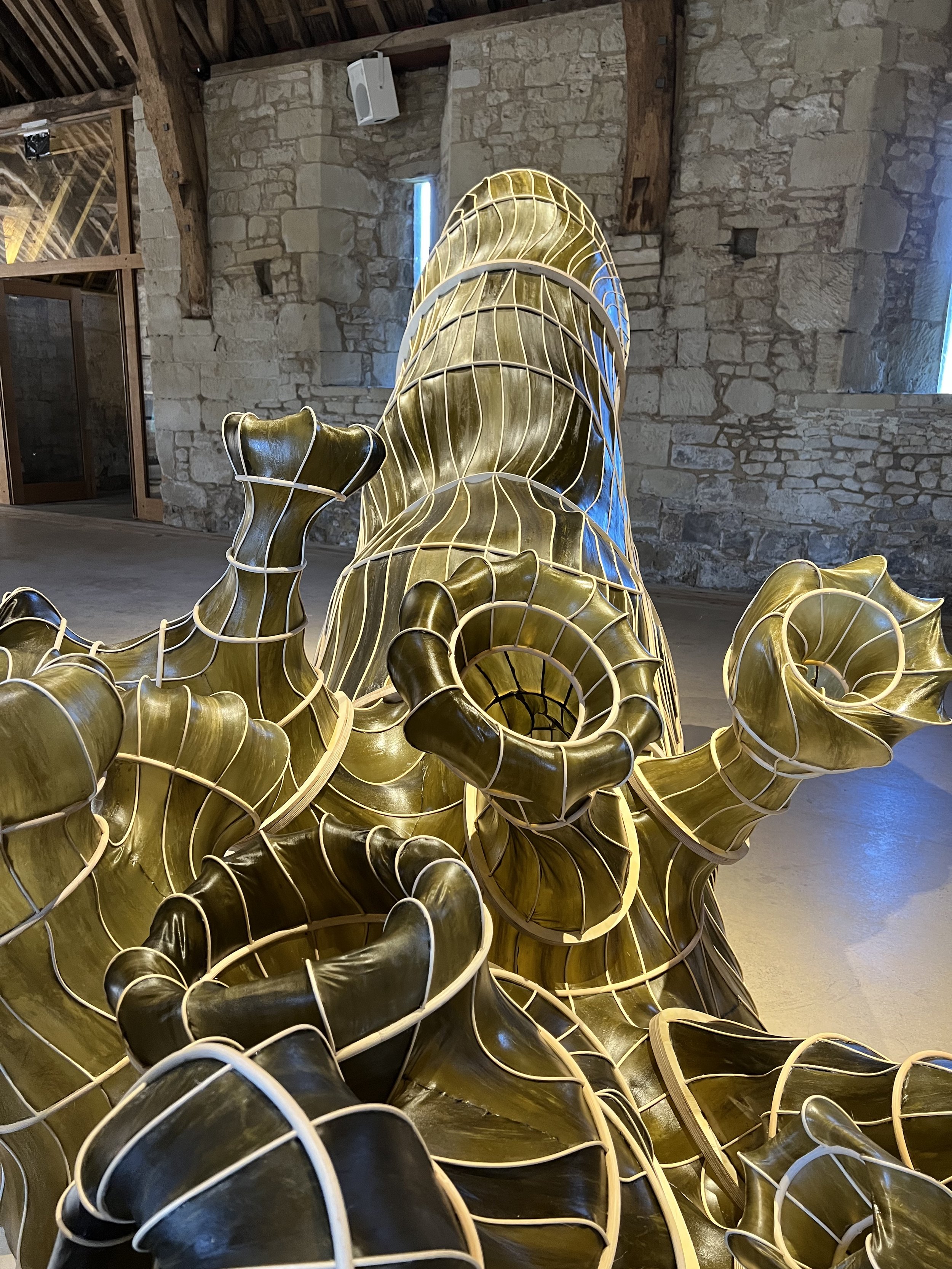

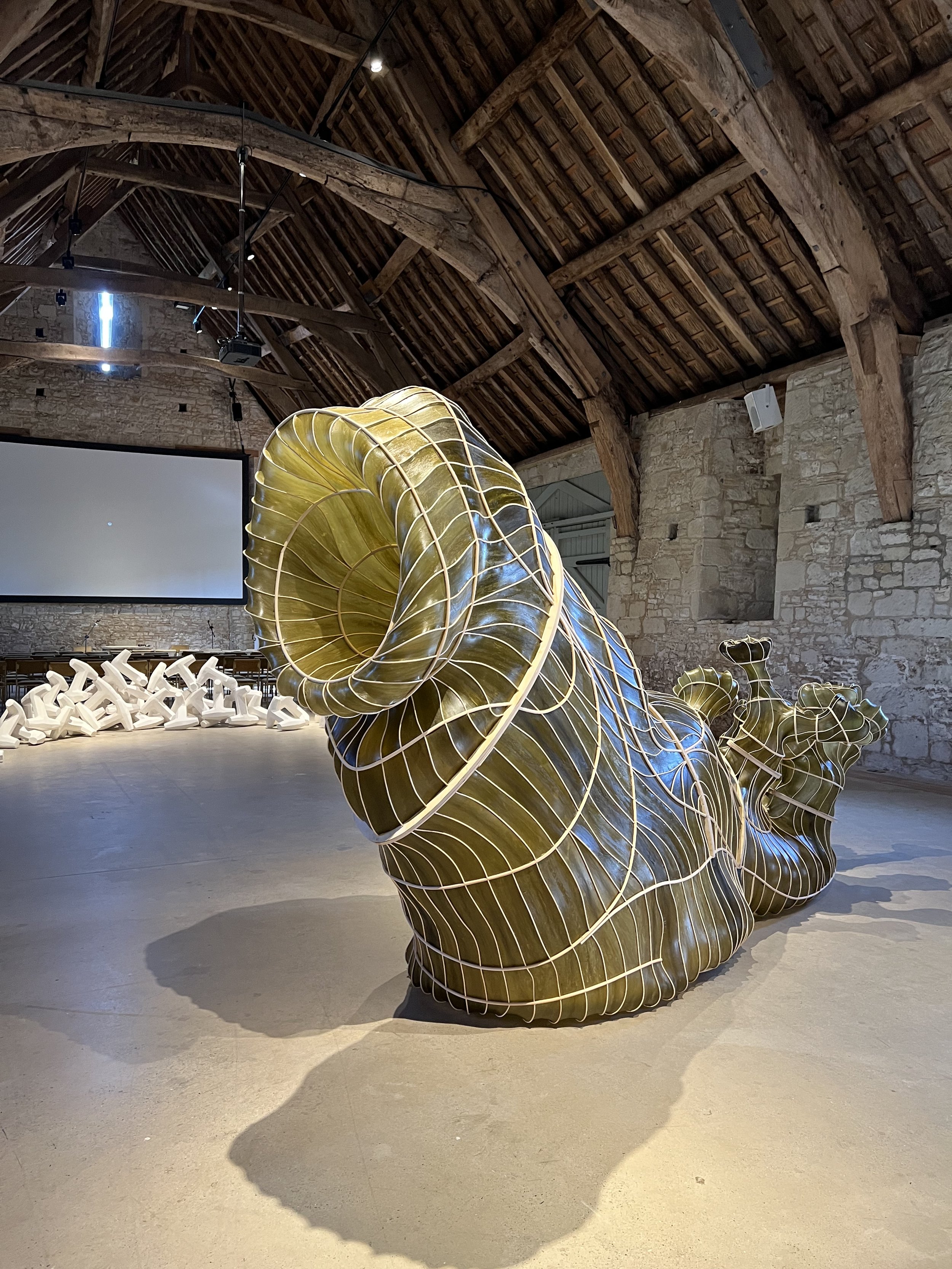




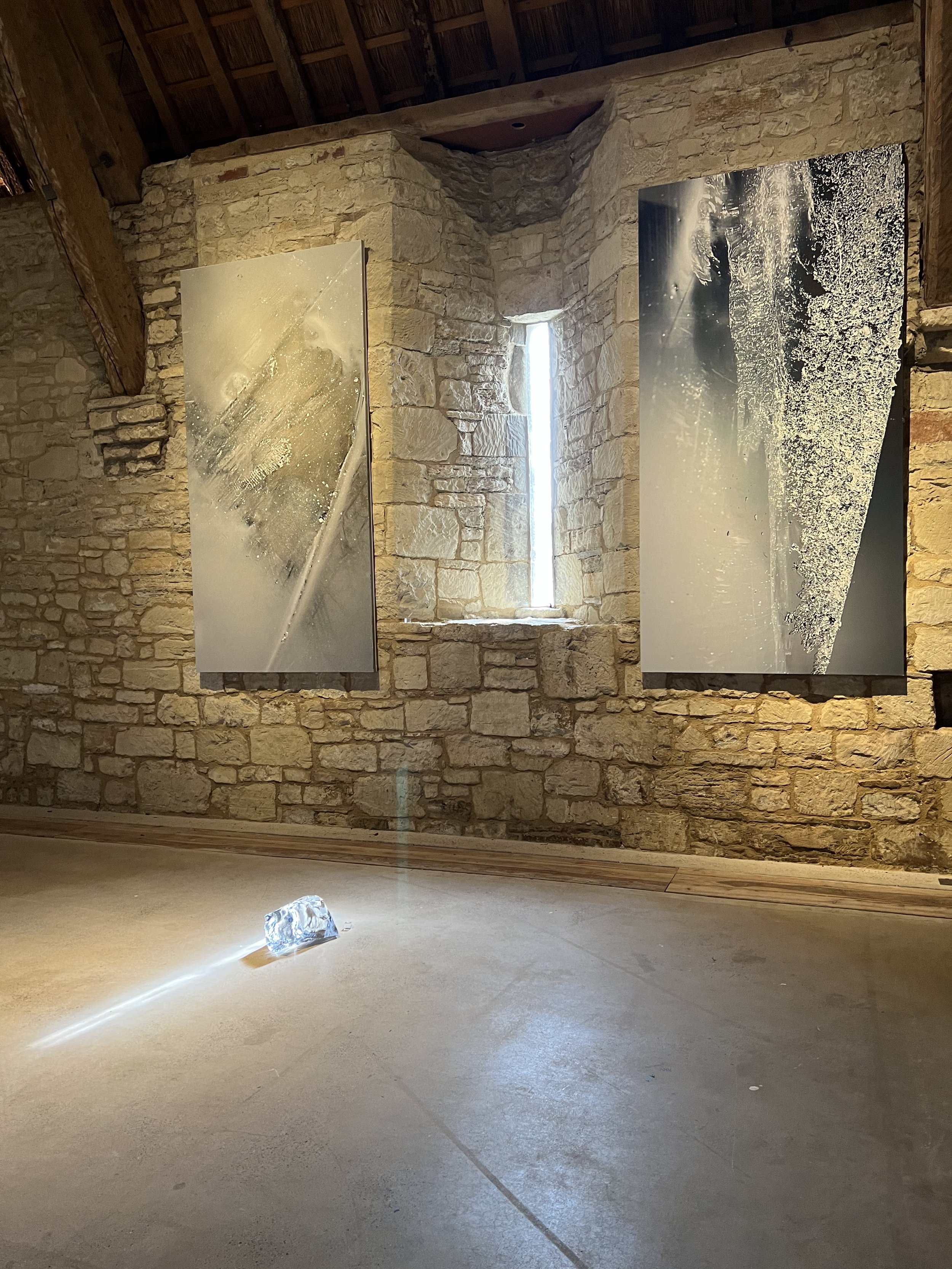
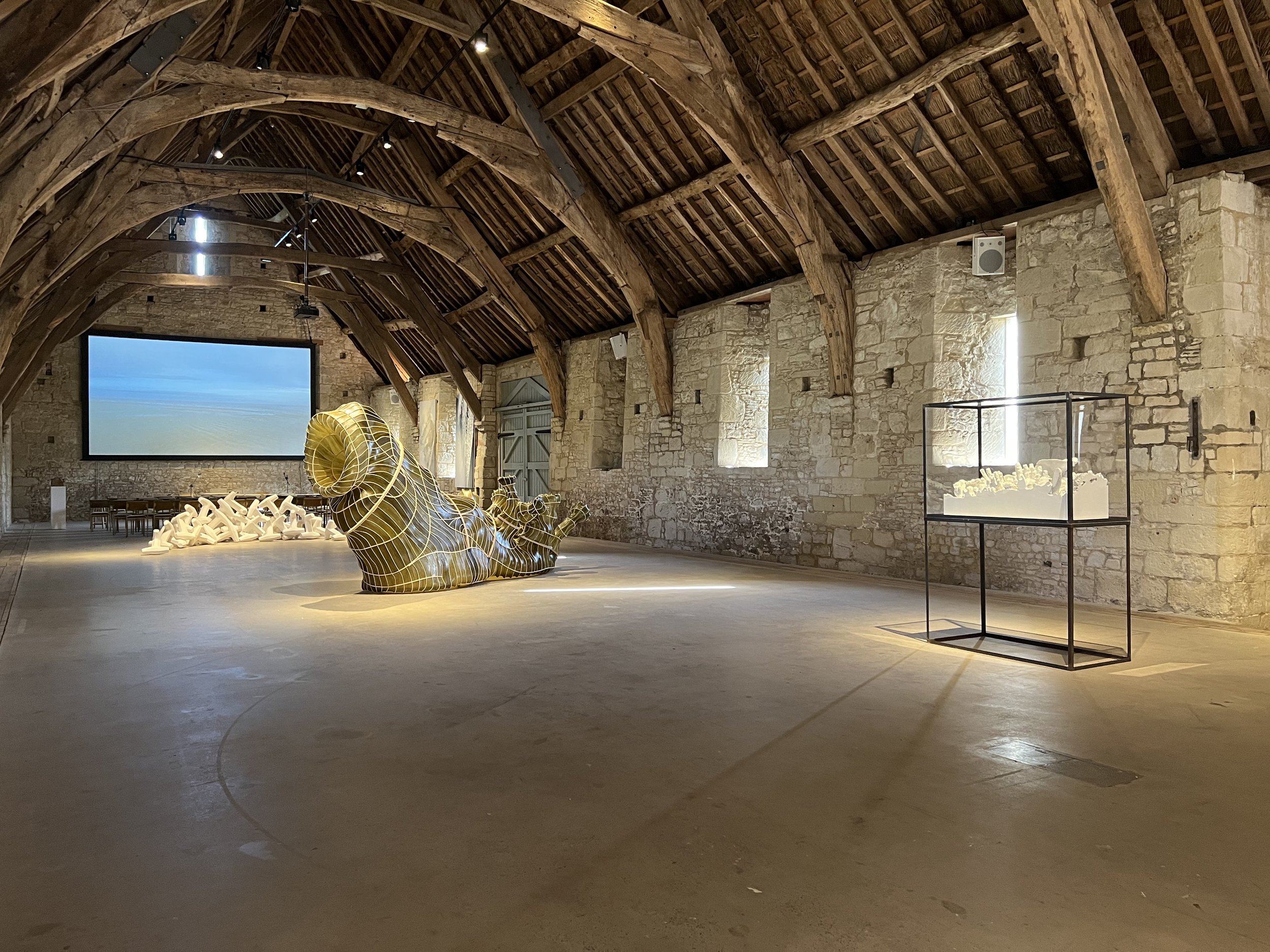
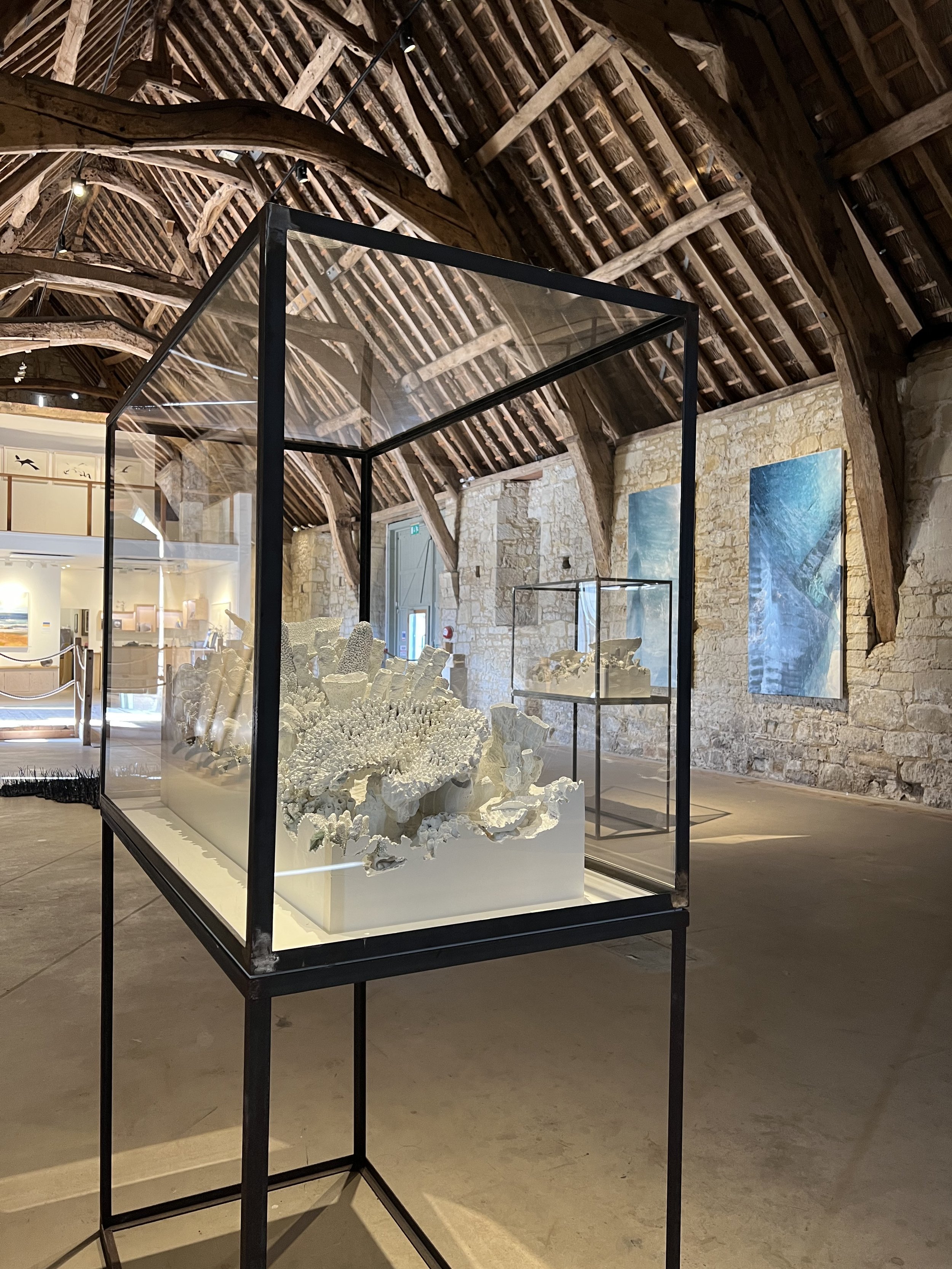
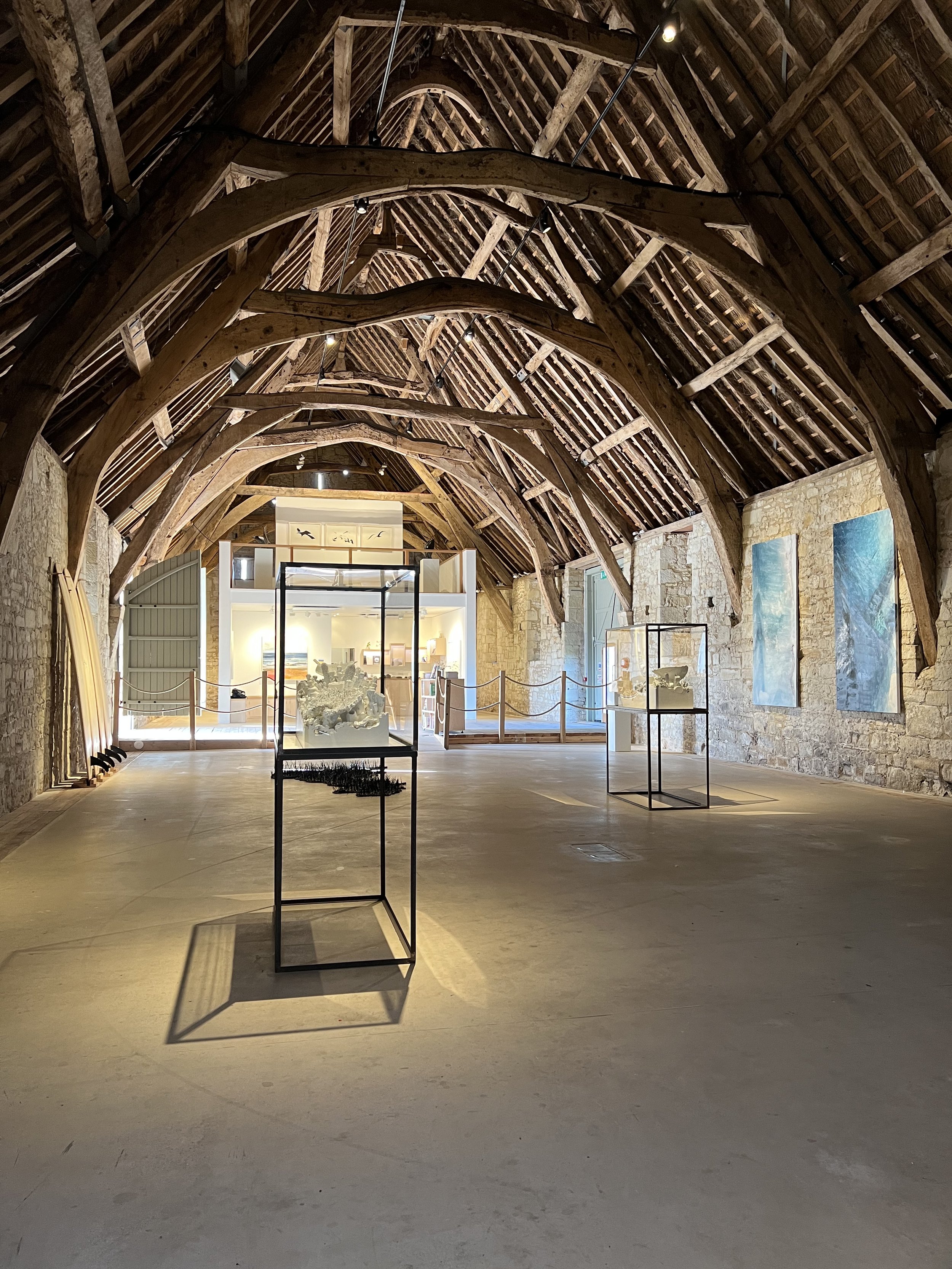
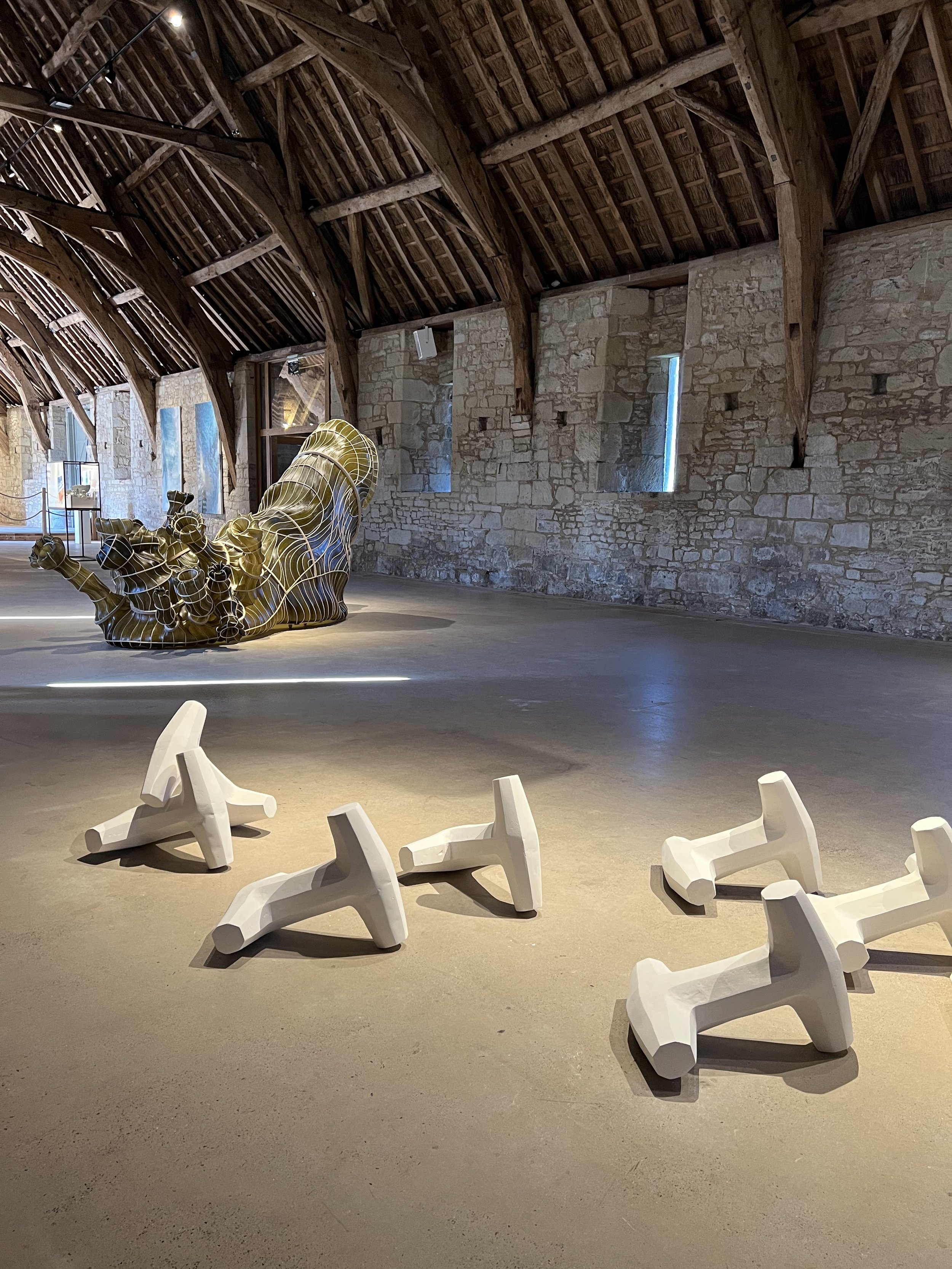
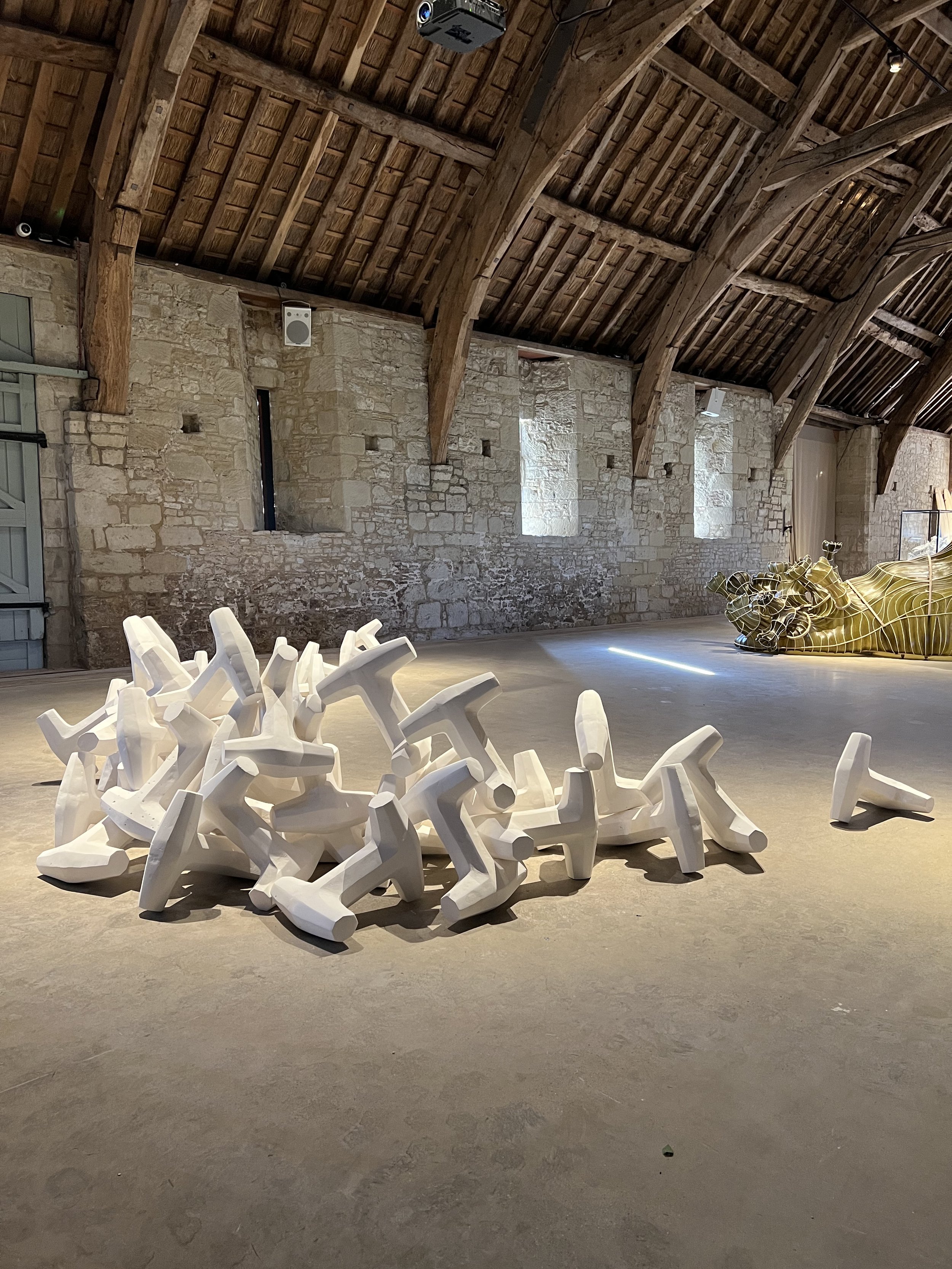

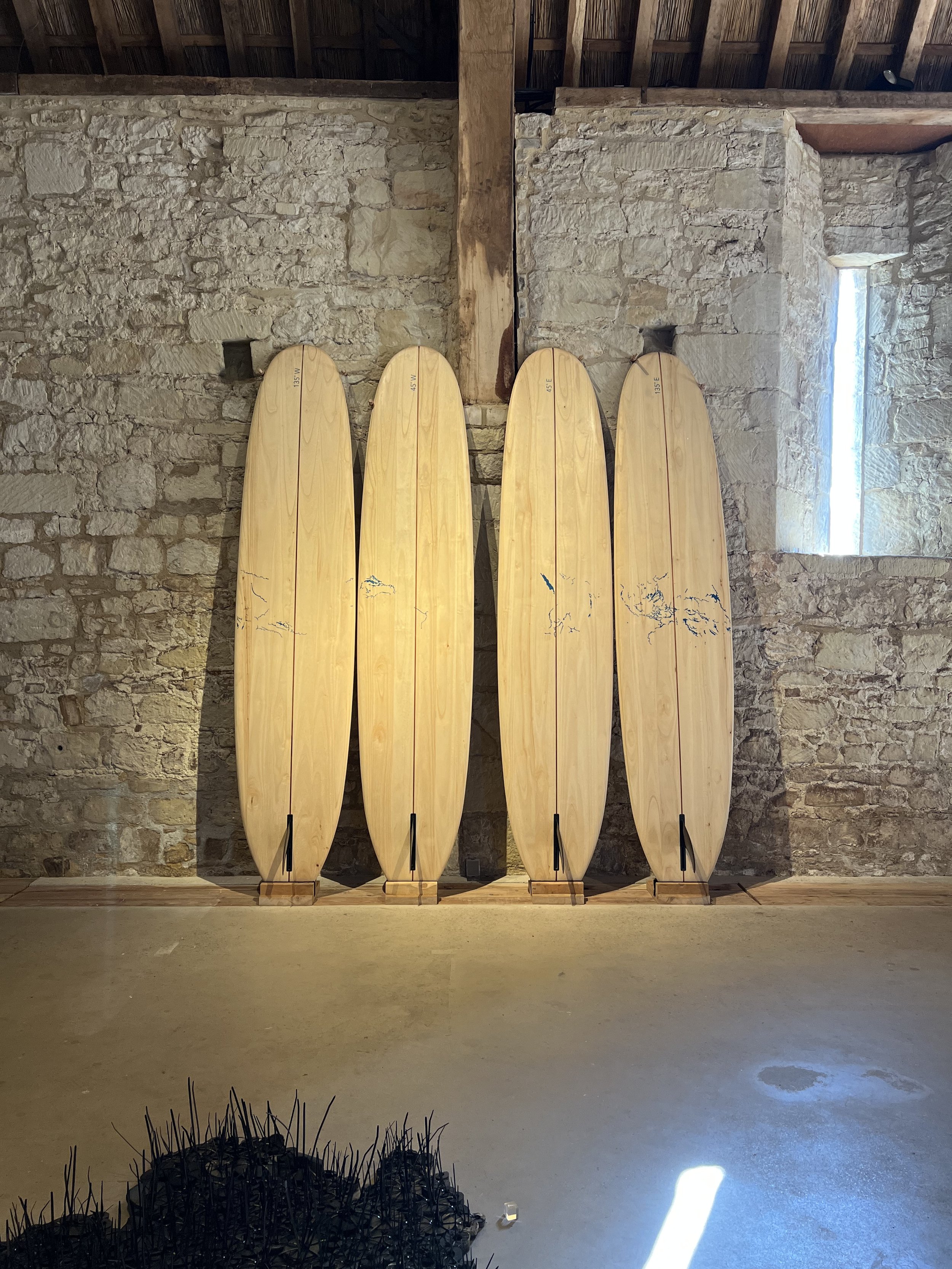
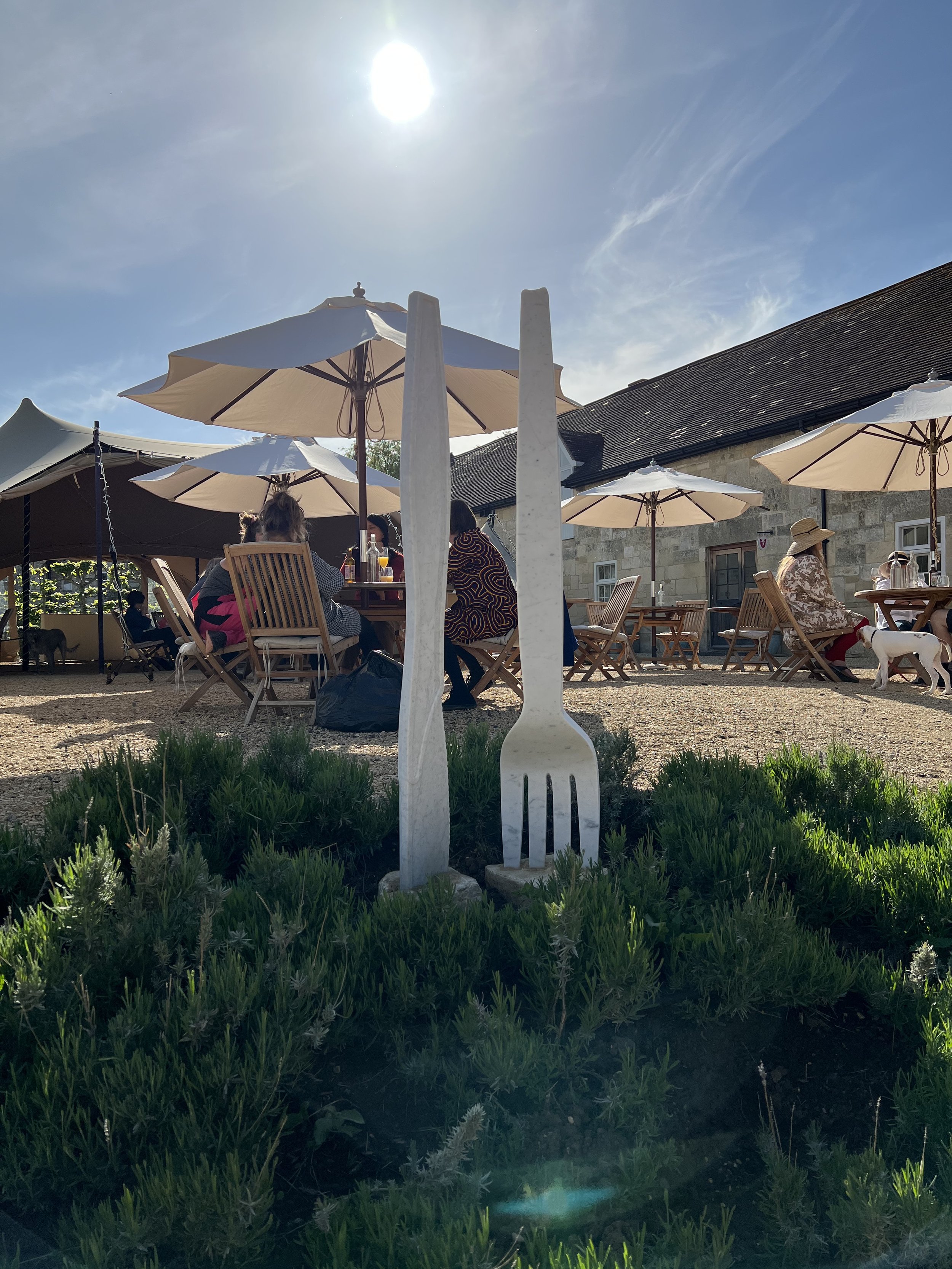








Installation photographs by Steve Russell (& a couple by me)
PRESS RELEASE
Simon Faithfull, Going Nowhere 1.5, 2016 (still)
Tideline
14 May – 3 July 2022
Messums West
Henrietta Armstrong, Wayne Binitie, Ros Burgin, Dorothy Cross, Simon Faithfull, Kurt Jackson, Tania Kovats, Julia Lohmann, Richard Long, Tom Waugh
At the centre of a programme devoted to rethinking our relationship with the environment is Messums’ 13th century tithe barn. The largest in the country, the barn gallery becomes a turbine hall for the imagination this summer starting with Tideline, a group exhibition running from 14 May – 3 July 2022.
Made of limestone and sitting on a reef of Upper Jurassic Tisbury coral 24 miles from the nearest beach at Rockley Sands in Poole, Messums’ historic gallery bears witness to the action of water over millennia as maker and unmaker of landscape.
At a time of accelerated shifts in sea levels and marine life brought on by human activity, Tideline examines artist responses to that most contested space, the littoral landscape. The area between land and sea carries with it the history of our earliest evolution, and remains one of the principal spaces for mankind’s dwelling. 634 million people live within a 10 vertical metre distance of current shorelines. This liminal environment, where animals and plants interact differently, pushed and pulled by rising and falling tides, holds both the threat to our future security as well as some of its solutions.
The artists selected by curator Isabel de Vasconcellos engage and expand our understanding of this extraordinary ecosystem and bellwether to change. Their work sets out not just to alert and inform, but to key into our empathy with the underwater environment, to sow the seeds of our imagination and drum up our own sense of agency for change. They remind us of human ingenuity’s boundless desire for discovery, and radiate with a light of possibility, inviting us to problem-solve and think the unthinkable.
Fresh from the launch of Corpus Maris I, commissioned for this year’s Sydney Biennale, and adopting a reduced footprint approach to making that is being supported locally by Messums Creative, Julia Lohmann fabricated a series of seaweed sculptures for the gallery in Wiltshire in March. A long-time champion of kelp as a material for reimagining living with our resources, Lohmann’s luminous structures suggest new propositions for sustainable creative practice. ‘Every species has an equal right to life on this planet. We can use the same human ingenuity that has led to the climate crisis we are facing now... to protect and regenerate the ecosystem that sustains us.’
Tom Waugh’s Anthropocene Fossils propose what paleontological specimens of the future might look like. Taking some of most eminently disposable yet least biodegradable objects of our era such as coffee cup lids, picnic cutlery and Styrofoam, Waugh carves them into salvaged stone and marble, ‘emerging from boulders and rocks like futuristic ammonites’. His Carrara marble Knife and Fork poke out of the slope between the Barn Gallery and the Mess Restaurant. Exquisitely hyper-realistic yet humorous, they confront the absurdity of our hunger for convenience at any cost.
Also outside the Barn is Ros Burgin’s Lifelines. Coral reefs are some of the richest and most diverse ecosystems on earth, representing an important source of food and income to more than 500 million people worldwide, and they perform a crucial role in coastal defence. They are formed of the calcium carbonate skeletons of corals, small, immobile organisms closely related to jellyfish. Under pressure from pollution, over-fishing, sea temperature rises and bleaching, reefs have declined by 50% since 1950. Burgin’s work maps out the world’s remaining tropical coral reefs across four handcrafted Lignum surfboards.
Inside, Tania Kovats’ Bleached anticipates what future museum presentations of these vital and fast-disappearing habitats might look like. Taking specially-fabricated coral from a decommissioned exhibit from The Deep aquarium in Hull, Kovats sliced through the reefs and presented them in a series of vitrines, first shown as part of Hull’s City of Culture in 2017.
Dorothy Cross’s Jellyfish Lake was inspired by the artist’s research into pioneering marine biologist Maud Delap, who in 1902 became the first person to rear jellyfish (in an aquarium at her home in Valentia Island, County Kerry) and to observe their full lifecycle. Filmed in the lakes of Palau Micronesia (itself at the sharp end of sea level rise), the video shows hundreds of tiny, delicate jellyfish swimming around the head and shoulders of a woman, whose hair floats with them in the swilling water. Lulling and dreamlike, the film captures a moment of coexistence that brings to mind Rachel Carson’s observation, ‘It is a curious situation that the sea, from which life first arose, should now be threatened by the activities of one form of that life. But the sea, though changed in a sinister way, will continue to exist; the threat is rather to life itself.’ The challenge now is to channel the curiosity of scientists and creative thinkers towards devising new activities and modes of existence.
Photographed during a 2015 visit to Iceland, the glaciers forming the basis for Wayne Binitie’s Liquid Paintings and Octet sculptures no longer exist. These works mark the beginning of a continuing collaboration with the British Antarctic Survey that saw Binitie’s work, Polar Zero, forming the centrepiece of an exhibition during the United Nations COP 26 Climate Conference last November. ‘The scale of the topic is so overwhelming and so complex that it can feel distant, even apocalyptic. People need something tangible to get hold of, that collapses that distance.’
In a small sand-island in the North Sea, a tiny figure filmed from a drone walks in ever decreasing circles around the tightening perimeter of the shore. As the tide comes in and eats away at the sliver of land, so it and the figure’s room for manoeuvre reduces and ultimately disappears, vanishing under the inevitable waves. Like other works in the show, Simon Faithfull’s Going Nowhere 1.5 brings humour and absurdity to bear on a situation which can seem hopeless and beyond our understanding.
Dolosse are reinforced concrete blocks used in large numbers as a form of coastal sea defence. First used in 1964 in the South African port city of East London, they have since proliferated in different geometric forms wherever sea level rise has started to encroach. The name Dolos is derived from the Afrikaans word for the ox knuckle-joint bones used in divination practices by healers. Henrietta Armstrong’s Throwing Bones II is an installation of 50 forms inspired by the Dolos, cast out of plaster and arranged in a random interlocking mass. Reminiscent of discarded baubles or games of chance, they touch playfully and lyrically on the landscape of risk and unknown consequences steadily transforming our shorelines.
In 2018, Richard Long produced a series of screen prints, based on drawings he made from mud taken from the banks of the tidal River Avon in Bristol, where he first played as a child. ‘Even as a kid I was fascinated by the enormous tide, and the mud banks, and the wash of the boats as they swept past... I guess it’s right to say that I have used that experience in my art: like water, the tides, the mud. All that cosmic energy is there in my work.’
Nature and the environment have informed Kurt Jackson’s practice ever since his university studies in Zoology at Oxford in the early 1980’s. ‘I paint the sea, her ways and guises, her manners and moods, as metaphor and topographical seascape. I see the pollution daily.’ Painted for Surfers Against Sewage in 2016, Mermaid’s Tears referred to the resin pellets and microplastics, now an indivisible facet of his turbulent and sublime seascapes. This mingling of poetry and menace has always been part of our dynamic with the sea, and informs the titles of his two paintings, She gives and takes, this big blue ocean, this carbon sink, this blue lung, and We breathe the ocean’s breath and she breathes ours.
Tideline addresses both the awareness but also the possible responses to the seen and unseen impacts of human activity on the bodies of water covering approximately 70.8% of the earth’s surface. It flags concern and also presents potential for change.
Complementing Tideline in the Barn as part of the concurrent programming, we present Ground in the Long Gallery, a survey of contemporary work to engage with landscape that takes the building blocks of the Common Ground movement as its starting point and looks at how landscape artists working today are helping to reshape our relationship with the soil though different ways of thinking and seeing.
Please join us to celebrate the launch of these exhibitions on Friday 13 May 2022, 6 – 8 pm. The shows will be open for press preview from 4pm on 13 May.
Please contact press@messumswiltshire.com for further details.
Julia Lohmann, Oki Naganode, Victoria & Albert Museum, London, 2013 (photo Petr Krejci)
Notes to editors
Henrietta Armstrong (b. Torquay, 1981) is a multimedia artist based in London, specialising in sculpture, installation and public art. She was recently selected as a finalist for the National Sculpture Prize 2021 and awarded as a runner up for the Soho House Art Prize 2020. She is currently working on a public art commission for the village of Tytherington commissioned by Cotswold Homes & South Gloucestershire Council. Recent exhibitions include National Sculpture Prize Exhibition at Broomhill Estate, TILT Summer Show at Hoxton Gallery, DOLOS - Rooftop Mural Project at Jealous Gallery, Art on a Postcard Summer Auction 2021 and Recreational Grounds: Off Site at Thames-Side Gallery. She is co-foundER of Come Quick Disaster, a platform for arts providing help & information for artists.
Wayne Binitie (b. London, 1967) collaborated with the Arts and Humanities Research Council, the British Antarctic Survey and Arup as part of his PhD at the Royal College of Art to create Polar Zero for the UN climate summit COP26 in Glasgow last year. He presented a cylindrical glass sculpture containing Antarctic air from 1765 – the date that many historians pinpoint as the beginning of the Industrial Revolution, alongside a second cylinder with an ice core containing tiny bubbles of air that were trapped as snow fell and compacted. Together, they provide an artistic marker of how much the earth's atmosphere has altered since that crucial date.
Ros Burgin is a sculptor who combines globally traded materials and a variety of processes and styles discovering new ways to shape and inform sculpture. She makes work that comments on sustainability, the marine environment and the part women play in shaping the collective values of society. Ecology is not only a theme but also an expression of her relationship with the world and is at the heart of an optimistic art practice advocating for lasting change where cooperation prevails over competition. Lifelines was first shown in Trinity Buoy Wharf as a partner in the Totally Thames Festival 2021, and supported by Arts Council England.
Working in sculpture, film and photography, Dorothy Cross (b. Cork, 1956) looks at relationships between body and time and the human and the natural world. Based on Ireland’s rural West Coast, Cross’s immediate environment is inseparable from her practice, present in the richly symbolic materials she uses to create strange and often unexpected encounters. In the early 90s, Cross came to widespread attention through a series of works featuring cow skins and cow udders. Since then, the artist has continued to work with organic matter, including whale skeletons, skull fragments and, at times, casts of her own body parts. The artist delves into the realm of geology and alchemy in the amalgamations of objects she creates, reinvigorating the lives of everyday things – sometimes humorous, sometimes disturbing, always intellectually stimulating and visually arresting. Cross’s work celebrates wonder and beauty despite the brevity of human existence.
Simon Faithfull’s (b. Ipsden, 1966) practice takes a variety of forms – ranging from video, to digital drawing, installation work and writing. He studied at Central St Martins and the University of Reading, and is Professor of Fine Art at The Slade School of Fine Art, UCL, London. Recent exhibitions include solo shows at the Atchugarry Foundation Miami (USA), Galerie Polaris (Paris), Kunstverein Sprinhornhof (Germany), The Exchange in Penzance (UK) and Musee des Beaux Arts (Calais). Recent group shows include exhibitions at Parafin (London), Maison Rouge (Paris), ACC Gwangju (Korea), Turner Contemporary (UK), CCCB (Barcelona), Palais de Tokyo (Paris) and Perth Institute of Contemporary Arts (Australia). In 2019 the first iteration of his public artwork ‘The Erratics’ was unveiled in Cambridge University (UK) and in 2010 his largest permanent public artwork to date ‘Liverpool-to-Liverpool’ was unveiled at the centre of Liverpool (UK). Faithfull’s works feature in many collections around the world including in France: Centre Pompidou, FRAC Basse Normandie & FRAC Franche-Comté; in England: in the Government Art Collection & the Arts Council Collection and also in the MAST Foundation in Italy amongst others.
Kurt Jackson’s (b. Blandford, 1961) artistic practice ranges from his trademark visceral plein-air sessions to studio work and embraces an extensive range of materials and techniques including mixed media, large canvases, print-making, the written word and sculpture. A dedication to and celebration of the environment is intrinsic to both his politics and his art; a holistic involvement with his subject informs his formal innovations. Jackson’s focus on the complexity, diversity and fragility of the natural world has led to artist-in-residencies on the Greenpeace ship Esperanza, the Eden Project and for nearly 20 years the Glastonbury Festival, which has become a staple of his annual working calendar. Four monographs on Jackson have been published by Lund Humphries depicting his career so far. Jackson regularly contributes to radio and television and presents environmentally informed art documentaries for the BBC and was the subject for an award-winning BBC documentary, ‘A Picture of Britain’. He has an Honorary Doctorate (DLitt) from Exeter University and is an Honorary Fellow of St Peter’s College, Oxford University. He is an ambassador for Survival International and frequently works with Greenpeace, WaterAid, Oxfam and Cornwall Wildlife Trust. He is a patron of human rights charity Prisoners of Conscience. He an academician at the Royal West of England Academy.
Tania Kovats (b. Brighton, 1966) studied at Newcastle Polytechnic and the Royal College of Art. Notable recent solo exhibitions include ‘Head To Mouth’, Berwick Gymnasium (2019), ‘Troubled Waters’, Phoenix Gallery, Exeter (2019), ‘Evaporation’, Museum of Science & Industry, Manchester (2016), ‘Oceans’, Fruitmarket Gallery, Edinburgh (2014). Important recent group exhibitions include ‘UnNatural History’ (curated by Invisible Dust), Herbert Museum & Art Gallery, Coventry (2021), ‘Future Knowledge’, Modern Art Oxford (2018), ‘Women Power Protest’, Birmingham Museum and Art Gallery (2018) and ‘Vita Vitale’, Palazzo Grassi, Venice (2015). In 1991 she was awarded the Barclays Young Artist Award at the Serpentine Gallery, London. In 2015 she was nominated for the Max Mara Art Prize for Women at the Whitechapel Gallery. Kovats’ work is held in numerous public and private collections including the Arts Council Collection, London, British Council, London, National Maritime Museum, London, Government Art Collection, London, Victoria & Albert Museum, London, Henry Moore Institute, Leeds, Jupiter ArtLand, Edinburgh, Fruitmarket Gallery, Edinburgh, Yale Center for British Art, New Haven and the Speed Museum, Kentucky. Kovats is currently Professor of Drawing and Making at DJCAD, University of Dundee.
German-born artist, designer and researcher Julia Lohmann (b. Hildesheim, 1977) investigates and critiques the ethical and material value systems underpinning our relationship with flora and fauna. She is Professor of Practice in Contemporary Design at Aalto University, Helsinki, where she also lives. Julia studied at the Royal College of Art, where she has also taught and completed an AHRC-funded collaborative PhD scholarship between the RCA and the Victoria & Albert Museum. As designer in residence at the V&A in 2013, she founded the Department of Seaweed, an interdisciplinary community of practice exploring the sustainable development of seaweed as a design material. As part of her advocacy, she made a seaweed pavilion for the 2020 World Economic Forum in Davos to engage delegates with issues facing the natural world. Julia Lohmann’s work is part of major public and private collections worldwide, including the Museum of Modern Art in New York, and has received awards, bursaries and support from the Esmée Fairbairn Foundation, the British Council, Jerwood Contemporary Makers, D&AD, Stanley Picker Gallery, Arts Foundation, Wellcome Trust and Cooper Hewitt Smithsonian Design Museum.
Richard Long (born Bristol, 1945) has been in the vanguard of conceptual art in Britain since he created A Line Made by Walking over half a century ago in 1967, while still a student. From that time he expanded his walks to wilderness regions all over the world, including a walk in the Alps that was documented by his first text work for the seminal exhibition of Minimal and Conceptual works entitled When Attitude Becomes Form at the Kunsthalle Bern in 1969. Richard Long was born in Bristol, UK in 1945. He studied at the West of England College of Art, Bristol (1962–65), then St Martin’s School of Art, London (1966–68). Major solo exhibitions include De Pont Museum, Tilburg, Netherlands (2019); Fondation CAB, Brussels, Belgium (2018); Houghton Hall, Norfolk, UK (2017); Arnolfini, Bristol, UK (2015); Hamburger Bahnhof, Berlin, Germany (2010); Tate Britain, London, UK (2009); Scottish National Gallery of Modern Art, Edinburgh, UK (2007); San Francisco Museum of Modern Art, CA, USA (2006); National Museum of Modern Art, Kyoto, Japan (1996); Philadelphia Museum of Art, Philadelphia, PA, USA (1994); and Solomon R. Guggenheim Museum, New York, NY, USA (1986). He represented Britain at the 37th Venice Biennale (1976) and won the Turner Prize in 1989. He received the Chevalier de l’Ordre des Arts et des Lettres from the French Ministry of Culture (1990), has been elected to the Royal Academy of Arts, London (2001), awarded Japan’s Praemium Imperiale in the field of sculpture (2009), made a CBE in 2013 and was knighted in the 2018 Honours List.
Tom Waugh (b. Tiverton 1978) is a British sculptor working from his Studio in West Somerset. He has been a member of the Royal Society of Sculptors since 2018. In 2005 he gained a First in Architectural Stone Carving at the City and Guilds of London Art School and has spent time in India studying traditional carving techniques with the temple carver Raja Saceran. His carving can be seen on St Pancras Station, St Martin in the fields and St Georges Chapel, Windsor and his Sculptures are exhibited widely and can be seen in the collections of Warwick University and Gladstone’s Library. Large scale public works include ‘The Lens’ at Harrow View West and ‘Leaving’ in the City of London in collaboration with Nicholas Dimbleby. He was a finalist in the 2021 National Sculpture Prize.
Sea Change
Saturday 14th May 2022
The exhibition includes a Talks programme on the opening day in two parts.
Morning: Sink or swim, what the ocean has to tell us and offer us.
Lunch
Afternoon: Safe ground - how do artists depicting the landscape today help and envisage change.
MESSUMS WILTSHIRE is a leading multi-purpose gallery and arts centre set inside a restored thirteenth- century tithe barn and surrounding buildings with exhibition space, sculpture garden and restaurant.
MESSUMS LONDON is a modernist gallery space on Cork Street.
A comprehensive list of past and future exhibitions can be found on our websites.


